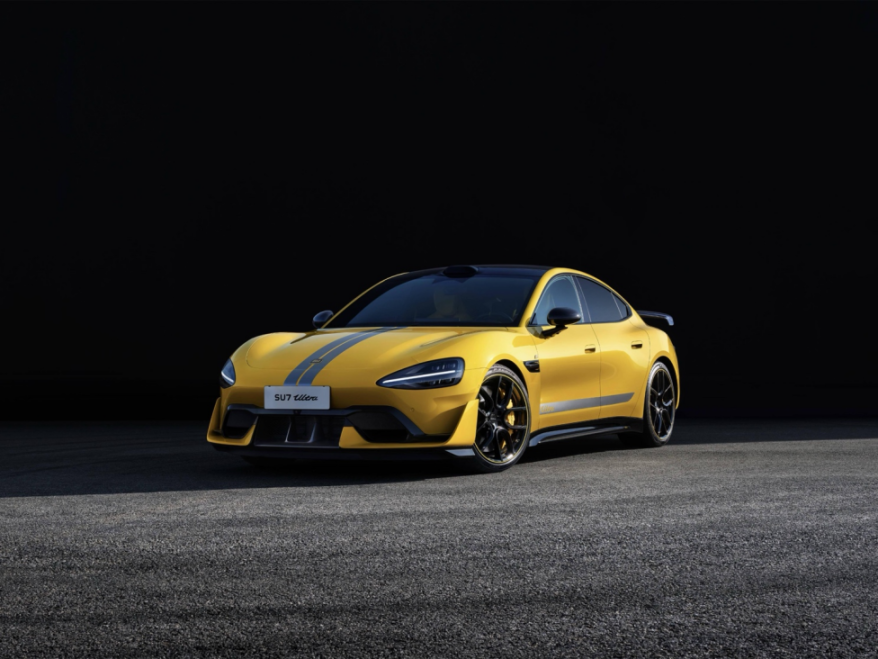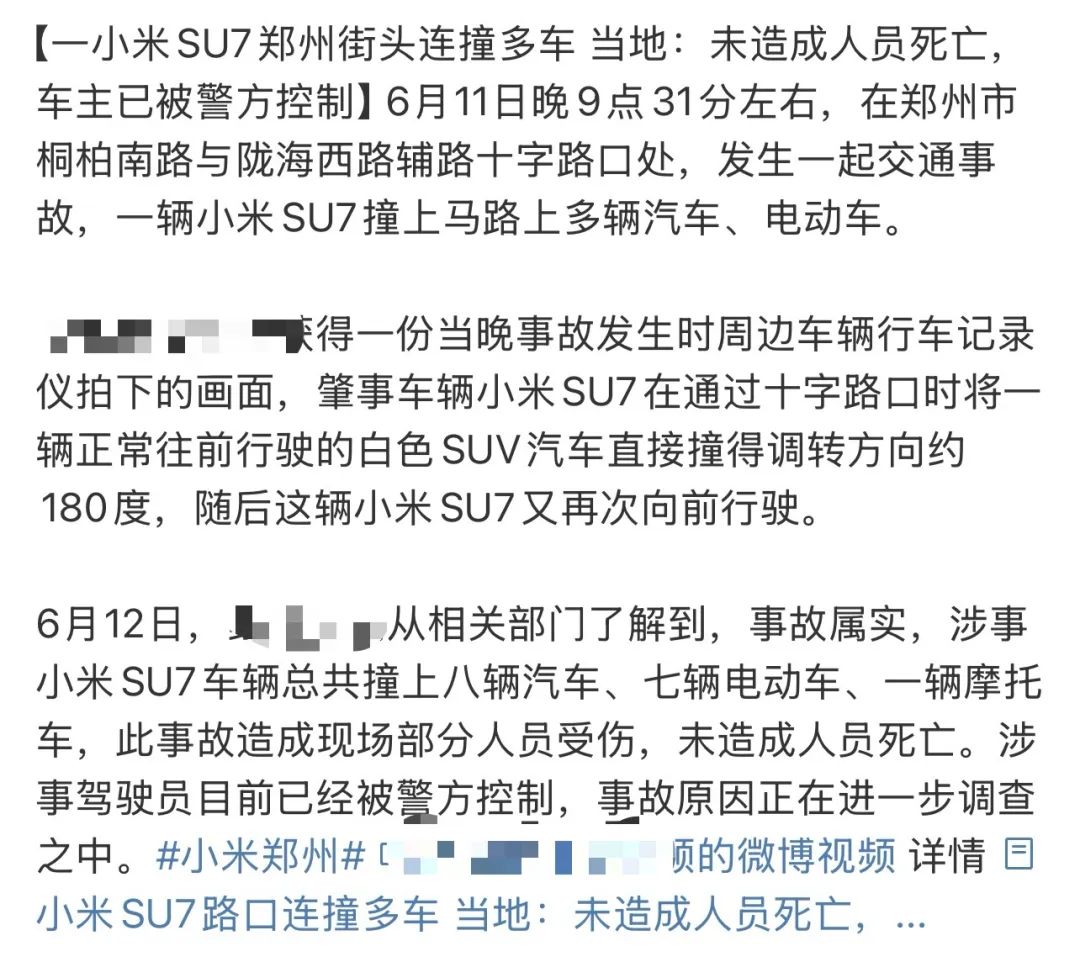Why Do Xiaomi Car Accidents Always Trend on Weibo?
![]() 06/13 2025
06/13 2025
![]() 610
610

Key Points:
1. Compared to accidents involving other brands, Xiaomi car accidents align with the viral content formula: high recognition + strong emotional drive + high discussability = trending topic.
2. Media content selection tends towards two directions: capturing topicality through the "Xiaomi + Car Accident" conflict narrative, and fostering engagement where netizens easily take sides, comment, and share.
3. Xiaomi car owners often lack driving experience commensurate with the vehicle's performance. High-performance cars require a certain level of driver skill; inexperienced or reckless drivers can easily lose control.
Author: Chang Yuan
Editor: Key Point Master
Last night, a traffic accident occurred in Zhengzhou, involving a Xiaomi car that collided with 17 vehicles consecutively. Today, this accident and the female driver involved have trended on Weibo, capturing public attention.
Key Point Master noticed a media report over 200 words long. It failed to clearly explain the cause, effect, and driver's background, but mentioned "Xiaomi SU7" seven times. It seemed as if the news casually mentioned a popular car model.
Over the past few months, multiple Xiaomi car accidents have successively trended on Weibo. While car accidents are common for automakers, "Car Accident + Xiaomi" naturally attracts attention. Is this due to a product issue? Or is it a collective phenomenon under the current communication mechanism? We attempt to dissect the reasons behind the "amplification of public opinion" in Xiaomi car accidents from a communication science perspective.

Why Xiaomi?
Compared to other brands, Xiaomi car accidents exhibit strong information dissemination adaptability. Simply put, they adhere to the viral content formula: high recognition + strong emotional drive + high discussability = trending topic.
When ordinary cars collide, passersby might glance twice. Even when a Xiaomi car drives normally, many people take a second look. The SU7's branded appearance and high design recognition, coupled with Lei Jun's personal promotion, make it a recognizable symbol on the road. When an accident occurs, it is easily surrounded, photographed, and disseminated. In contrast, other contemporary new energy vehicles are mostly ignored in accidents due to insufficient brand presence and converging designs.
Xiaomi's current deliveries are still in the early stages, with cumulative deliveries of less than 200,000 units scattered across the country, resulting in low street presence. This rarity triggers a primacy effect: when an accident occurs, the public tends to generalize and wonder if there is something wrong with the car.
For example, when a photo of a Xiaomi car rear-ending another vehicle in a tunnel emerged, netizens immediately shifted focus from the responsibility of the rear-ending to whether Xiaomi's braking system was faulty.
In a rational context, this causality clearly does not hold. However, driven by social media emotions, logic often takes precedence over facts, and with Lei Jun's famous quotes or dubbing, it can quickly trend on Weibo.
Xiaomi is one of the very few automotive brands that "comes with traffic." Whether you are a Xiaomi fan or not, as long as you go online, you have probably heard Lei Jun's famous quotes, such as "This is the last venture of my life." These words raise public expectations and lay the groundwork for verification. Every car accident is seen by some as an opportunity to "slap in the face," highlighting a weakness of human nature.
Who is sharing and who is watching?
In most cases, traffic accidents should be reported by local news. However, in Xiaomi's case, accidents occurring anywhere in the country can ferment into trending topics on Weibo. This is not accidental but a natural outcome of the social network communication mechanism.
Media has two tendencies when selecting content: capturing topicality through the "Xiaomi + Car Accident" conflict narrative, and fostering engagement where netizens easily take sides, comment, and share.
As a result, whether it's a mainstream media outlet or a self-media account, they love to use phrases like "Did Xiaomi Car have another accident?" or "Confidently driving powerful, can you really handle it?" to attract attention. The phenomenon of mentioning the car model name seven times in a 200-word news article mentioned earlier is also a result of this tendency.
After such content is published, it easily triggers group-voting-style comments. Some raise questions, some provide information, and others just want to watch the chaos, resulting in high interaction data.
Compared to cold public account push notifications, car accident videos/images in WeChat Moments and group chats have more penetration power. Many people's first reaction upon seeing an SU7 accident video is not to analyze the accident responsibility but to ask, "Is this Xiaomi?" or "Is Xiaomi safe?" It's evident that Xiaomi cars have transformed from products into a certain kind of "topical object."
Of course, given the current level of competition and ethics among domestic automakers, there's also the possibility that rival companies are maliciously trying to gain traffic. Let's set that aside for now.
This is also why the public is still willing to spread the news even if the accident itself is not Xiaomi's fault. Because it's a topic where one can participate in discussions and express attitudes.
Who are the car owners, and how do they drive?
Beyond discussing dissemination, we must also consider the accidents themselves: Are Xiaomi cars more prone to accidents? Currently, there's no official statistical data to support this conclusion. However, from the product positioning and user personas, there are indeed several risk factors.
First, Xiaomi cars emphasize "performance," with the fastest 0-100km/h acceleration time being 2.78 seconds, and many models come standard with a sport mode. In promotions, "Confidently driving powerful" has become the core slogan. Xiaomi also uses race track results like the Nürburgring as main promotional points. Early users tend to be tech enthusiasts and young people more sensitive to new technologies and speed, prone to aggressive driving.
However, strong performance does not equate to ease of driving. Many Xiaomi SU7 car owners' feedback online can be summarized as: it has strong power, and stepping on the accelerator feels like being shot out. If you haven't driven an electric car before, it's indeed not easy to master at first.
Second, Xiaomi car owners generally lack driving experience commensurate with the vehicle's performance level. Many traditional car owners need to adapt to the response habits of brakes and accelerators when switching from gasoline cars to electric cars. Among SU7 users, there are many first-time car buyers. In this context, settings like strong power, single-pedal mode, and energy recovery can easily lead to more frequent unstable driving situations.
This also means that minor accidents that could have been avoided can easily escalate into severe collisions when the driver lacks experience.
Third, there's a gap between official promotions and actual use. Xiaomi officials have repeatedly emphasized that the driving experience of the SU7 is "comparable to million-yuan luxury cars," leading some users to mistakenly believe they can "easily handle high performance." But the reality is that any car emphasizing power output has a certain threshold for drivers. Without experience or respect, it's easy to lose control. Of course, Xiaomi has realized this problem and taken practical measures, such as strengthening safety driving training for car owners.
Accidents are not the problem, emotions are the key
Automobiles are highly complex industrial products, and traffic accidents are not uncommon. The problem Xiaomi faces is being under a "traffic magnifying glass," where even minor collisions may evolve into trending events. Furthermore, when a car accident ferments into an incident, Xiaomi becomes a public topic on social networks. It's no longer just Lei Jun's dream or a means of transportation for over a hundred thousand users but a traffic symbol everyone can watch and judge.
This is not just a problem for Xiaomi but also a challenge for every "traffic brand": the more popular you are, the more careful you need to be with every piece of information.
In summary, the frequent trending of Xiaomi SU7 car accidents on Weibo may not be because it's prone to accidents but because it's at the intersection of various communication mechanisms. We can see how a brand with high recognition is more easily focused on, how a product amplifies discussion due to its inherent emotional field, and how a group of users push public opinion towards polarization due to the gap between expectations and reality.
In the future, whether Xiaomi can properly handle negative trending topics about accidents will depend on whether it can regain public trust afterward. Before that, every accident is a comprehensive test of Xiaomi's brand strength, product strength, and public relations capabilities. Moreover, this is the real public opinion environment for new-era automakers. Xiaomi just happens to be under the spotlight, and everyone is still holding a magnifying glass.








